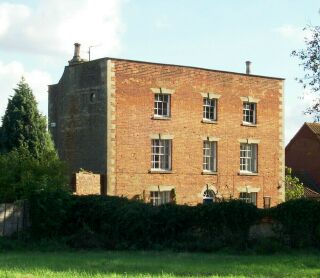|
Dyke
The Car Dyke, built by the Romans and connecting Lincoln with Peterborough and beyond, runs through this village which is how it gets its name.
Henry Penn, the famous 18th century bell-founder, cast one of the bells for Lincoln Cathedral at his foundry in Peterborough in 1717 and sent it to Lincoln on a raft, passing through this village. The bell, weighing just over 12 cwt, was transported at a cost of £8 13s. 0d (around £2,000 at today's values), which indicates that the waterway was still navigable more than 1,500 years after it was built
and is still known by some as the Bell Dyke. The Penn bell is now the sixth in the ring of eight bells hanging in the south west (St Hugh's) tower of the
Cathedral.
Small but not
insignificant appears to be the motto of Dyke village whose heritage is
proclaimed in this new carved sign that was erected in 2001. It depicts
all that this place is famous for, the old smock mill, the Car Dyke and
a mention in the Domesday Book of 1086.
The village hall
is a strange looking building but perfectly functional for its current purpose.
It is built of corrugated zinc and was originally erected at Belton Park, near Grantham,
where it was known as St George's Mission and had been used for church services
by army personnel stationed there during the First World War. After the
Armistice, many of these military buildings were sold off or given away by the War Office and
in 1920, this one was moved in sections by tractor and trailer to a piece of land at Dyke
supplied by the Bettinson family where it was re-erected and used by the
community for social events and meetings.
In
1978, when its future came under review, a village hall committee was formed and
since then almost the entire village has been involved in its running and
upkeep, extending the floor space by an additional building at the rear to cope
with an expanding population, and it has become the centre of social life in
Dyke ever since.
|
A VILLAGE HALL SCRAPBOOK |
|
 |
|
The village hall is built of corrugated
metal and stands on brick columns but its cold external appearance
gives way to a warm and welcoming interior which is one of the
reasons for its popularity, being used on most evenings for a wide
variety of social events and in recent years it has become the
focal point of village life. |
|
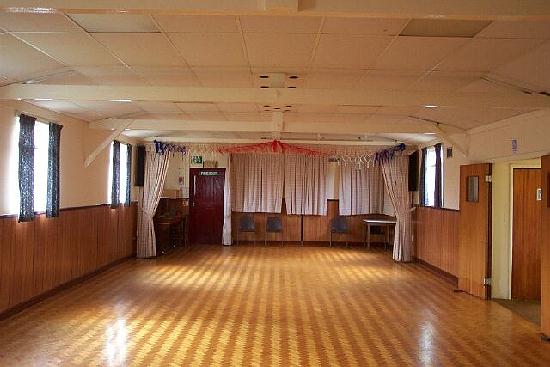 |
|
 |
|
The 15th annual general meeting of the Dyke
Village Hall Management Committee on Monday 24th April 1995.
In the picture left to right: Seated - Sheila Bailey
(secretary), David Stubbs (chairman) and Pat Broxholme (treasurer);
standing - Councillor Janet Sauter, Olixe Laxton, Councillor Don
Fisher, Christine Woods, Steven Dodson, Susan Barnett, John Carlton
(vice-chairman), Marion Cropley and Charlotte Stubbs. |
|
 |
The
village green dates from mediaeval times and as the centre of a self-sufficient
community, its main purpose was probably to enclose the village livestock that
were impounded at night against predators, both wild and human. They survive in
all shapes and sizes, some large enough for a game of cricket on a Sunday
afternoon while others barely have room for a war memorial or a maypole, yet
they are still the heart of the village and to know something of their origins
is to understand more about their role in the history of the community they
serve. The green is now far too small to accommodate today's summer festivities
that are now held on the nearby recreation ground, but it survives as a reminder
of the way things were.
The most recent addition to the street scene has been a water feature on the village green known as the Dyke Millennium Well. There is an artesian well at this point that once supplied water to the community through standpipes in the street but these became obsolete when mains water was installed in 1953. The bore was tapped again towards the end of 2001 to create the present feature under the direction of David Stubbs, a lifelong resident of the village who acted as project engineer. It took several attempts and seven tons of concrete to contain the bore within a test tank and once this was done, Peter Machin completed the surround in yellow brick. The operation was a difficult one but water from the bore is now fed into the stainless steel tank housed within the structure through a four-inch pipe and is afterwards piped into the Car Dyke. The entire water feature is maintenance free and cost £3,000.
This was one of several new features to mark the millennium, the others being the carved oak sign, a copse planted by children on the playing field and a flagpole outside the village hall which was used for its first important occasion to fly the Union Jack at half mast to commemorate the death of Queen Elizabeth the Queen Mother on 30th March 2002. All were financed by four years of social events and other fund raising activities.
Overlooking the village green is Britain House, a
Georgian property with an untouched front façade and a flat roof and once one of
the grandest houses in the village and it still retains its original windows and
front door with a glazed sunburst above while further along the main street is
Redmile Farm, a beautifully restored stone and thatched farmhouse.
A quaint red-brick
building dating back to the 19th century lies at the end of a cart track off the main street in Dyke and it is known to villagers as the Dovecote.
It was not built for birds but for a Victorian farm labourer and his family which is why it stands next to the fields and several large families were subsequently raised there but it has been standing empty these past fifty years and
now attracts pigeons and doves which is why it has earned its nickname.
Three small estates of council houses were built
in the village during the 20th century, firstly in the main street at the
eastern end where the eight properties dating from 1937 are still
in useful occupation. At the western end of the village, a complex of ten
bungalows was built in 1960-62 on the site on ten farm cottages that had been
condemned as being unfit for human habitation and was named Stubbs Close after local councillor Cecil Stubbs although he died before the work was
complete. A further four houses were built on a site across the road in 1952.
There
was also a Methodist meeting place here, established in a private house in
the Main Street adjoining No 63. In 1835, there were only five members,
rising to 30 by the mid-19th century but membership then gradually fell
away. There were moves in 1878 to secure a piece of freehold land to build
a permanent chapel but this did not materialise and during the 1980s,
membership dwindled and when the then owner of the house, William Morton,
died, the new occupants did not encourage the Methodists to stay and
consequently the cause was closed in Dyke and the chapel became a private
residence.
|
The Methodist meeting place was established
at a cottage in Main Street adjoining No 63 and rented from Mr
William Morton. It was in use for 100 years with services every
Sunday afternoon although attendance was rarely more than ten or
twelve. The cottage had previously been used as a schoolroom during
the 19th century and the old desks remained until well into the 20th
century. |
 |
|
FOOT AND MOUTH SCARE |
|
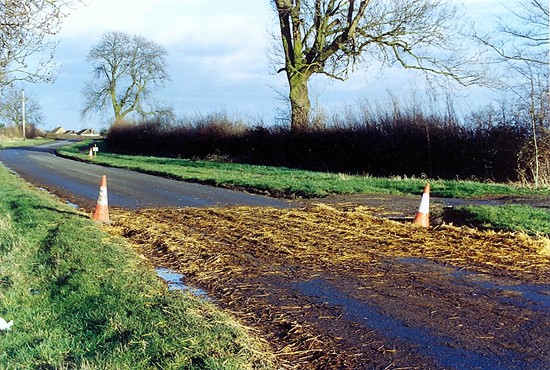 |
|
Roads in farming areas such as here at Dyke were disinfected to
prevent the spread of the contagion by passing vehicles during the
foot and mouth outbreak of 2001 which caused a crisis in the farming
industry with 2,000 cases of the disease in farms across the country
and the slaughter of 10 million sheep and cattle in an eventually
successful attempt to halt the disease. |
|
DYKE
IN PAST TIMES
|
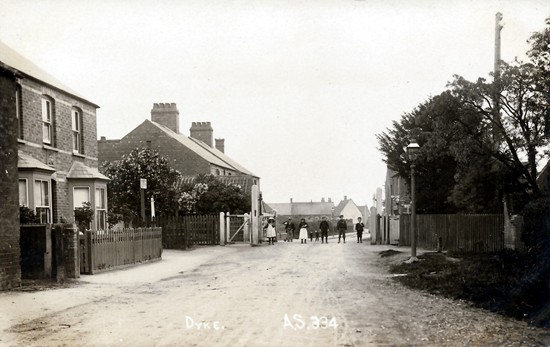 |
|
The main street in Dyke photographed circa
1925 by Ashby Swift showing the level crossing with a crowd of
inquisitive village children. |
|

|
|
Hay making and
harvesting were the times when everyone pitched in to help down on
the farm for when the sun shone, it was essential to get the work
done before the weather changed. This picture was taken at Dyke around 1910 by
a British-born American, Arthur Wilkinson, whose mother, Esther
Ann Tory, was born in the village and who made an annual pilgrimage
to keep in touch with relatives. The photograph was sent to me by his son
Robert Wilkinson of Newton, Massachusetts, who thinks that it may
have been taken on Cooper's Farm because one of the people his
father used to visit was farmer's wife Ethel Cooper. He is also
intrigued that some of the women appear to be wearing uniforms or
were they merely in their Sunday best posing for the photographer? |
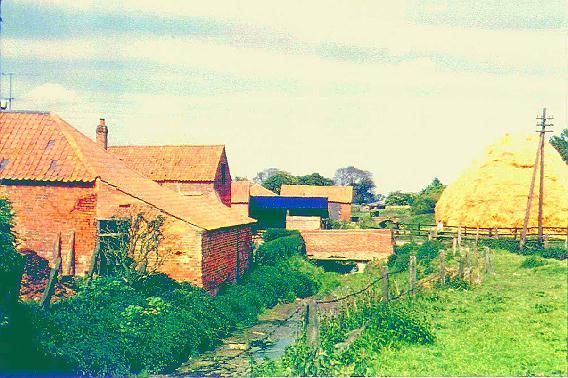 |
|
This colour
photograph was taken by Arthur's older brother, Mr Fred Wilkinson, who
went to live at Bradford in Yorkshire, where he became an
architect, and also taught at Bradford Technical College. His two
eldest sons emigrated, one to Kenya and the other to Canada. He
served in the army in Italy during the Great War of 1914-18 and in
1962, made a sentimental trip back to Dyke where he had enjoyed so
many happy memories of his childhood and took this and several
more pictures. Fred died
in 1975 at the age of 86. |
|
FROM THE ARCHIVES
|
|
Stolen or strayed on the 7th of this instant
December, a black-brown cow marked with the Dyke town brand and an
I S on the horn. Whoever gives notice of the said cow to Elizabeth
Young of Dyke, near Bourne, so that she may be had again, shall
have ten shillings reward. - public notice from the Stamford
Mercury, Thursday 11th December 1740.
The annual treat to the children of the Baptist school in this
hamlet was given on Tuesday afternoon, July 20th: the
old-fashioned barn of Mr C Redmile was kindly lent for the
occasion. After the children had had their tea, between 50 and 60
persons sat down to partake of the beverage which "cheers but not
inebriates". Addresses were delivered to the children, their
parents, and visitors, by Messrs Fox, Peggs and Todd. Every
scholar received a present of a book, and all departed well
pleased with what they had seen. One person present liberally
subscribed to the school; and it is intended to expend the
donation to the purchase of bibles for the children, which through
the happy abolition of the bible monopoly may now be purchased at
one shilling and sixpence each. - news report from the Stamford
Mercury, Friday 30th July 1841. The
heretofore quiet village of Dyke has latterly followed the fashion
of more populous places and established a "night jury" whose
pranks have been various. The little unpretending chapel has been
entered and ransacked; sundry chimneys have been stopped up at the
top, to the dreadful annoyance and wonder of the inmates of the
houses who were raving for their breakfasts; some of the
inhabitants were fastened into their dwellings; whilst on top of a
chimney of one might be seen a huge gate. These sundry other
misdoings have sadly disturbed the gravity and good feeling of the
inhabitants. - news item from the Stamford Mercury, Friday 24th
March 1848. Mr William Edwards, coroner, held an inquest at
Dyke on the 3rd inst., on the body of a child named John Cooper,
aged two years, who was unfortunately drowned in a washdyke
[drainage channel] upon the farm of Mr Edward Hardwick. The mother
of the deceased was gleaning within a few yards of the accident, and
the child had, unperceived, wandered away with some other children
and was found in the water within a few minutes, but too late to
restore life. His cap had fallen into the dyke and in trying to
recover it he lost his footing and fell into the water and the side
being steep, he was unable to extricate himself and his companions
too young to assist except by giving the alarm and calling for help.
Verdict, accidentally drowned.
- news report from the Stamford Mercury, Friday 6th August 1858. INQUEST: On Friday, the 16th inst., an
inquest was held at Dyke before J G Calthrop Esq., coroner, on the
body of Mrs Baines, the wife of a waggoner in the employ of Mr
George Bettinson. It appeared that the woman had but a few weeks
previously ceased to be an inmate of a lunatic asylum, and had
recently been much depressed. On Wednesday morning (the 14th) she
went into a neighbour's house and excitedly said: "I have taken
poison" and a few hours afterwards died in great agony. A verdict
of "temporary insanity" was returned. - news report from the
Grantham Journal, Saturday 24th November 1877.
HORTICULTURAL: Such weather as we have lately experienced
proves the value of cold houses, frames, and plant protectors
generally, for sheltering from the rigours of our climate. A box
of flowers before us, gathered in an unheated house, in Mr Benoni
Gilbert's Anemone Nursery at Dyke, near Bourne, contains a
delightful array of blossoms of Anemone fungens, Anemone King of
Scarlets, a beautiful new double scarlet of the brightest hue; the
very fine white primrose, Harbinger, Marie Loiuse, and Compte
Brazzas double white violets, etc., all of great size and purity
of colour and which with Mr Gilbert are flowering in great
abundance. - news item from the Gardening World, Saturday 27th
March 1886.
Clement Laxton, aged 29, an army reserve man, who has been
working as a farm labourer at Dyke, was found dead by the roadside
on Wednesday night. He had made arrangements about the next day's
work and was gathering green food for rabbits when last seen
alive. - news item from the Stamford Mercury, Friday 5th May
1899. |
|
AIR TRAGEDY NEAR BOURNE
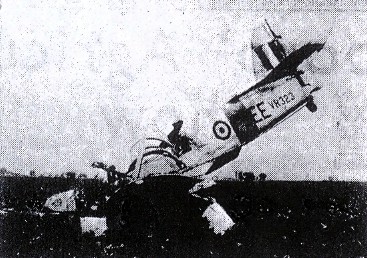
Newspaper photograph of the fatal crash
A Prentice trainer crashed in a field at Dyke
Fen, near Bourne, on Tuesday barely half a mile from the spot
where another training plane came down early last month. The
occupant, Cadet Officer Arthur Edward Short, aged 43, of Oxford
Road, Thornaby-on-Tees, who was stationed at Cottesmore, was
killed instantly as the plane buried its nose deep in the earth.
No person actually witnessed the crash although the plane was seen
circling the area and Mr Cecil Stubbs, of Dyke, saw it going into
a dive before it was hidden by trees.
Farm workers weeding in a field owned by Messrs Ash and Sons of
Dyke, noticed the plane flying in a perfectly normal manner and
paid little attention to it as aircraft are a common sight in this
low flying area. Frank Bailey, of Dyke, said that he suddenly
heard the engine of the plane "rev up". Then he heard a crash and,
looking round, saw that there had been an accident. The men left
their work and hurried to the scene but thought it better not to
attempt to free the pilot. He was later extricated with difficulty
by the driver of the Bourne ambulance, Mr E Robinson, police
Sergeant Green and P C Swann, all of whom were swiftly on the
spot.
The propeller and engine of the plane had been forced underground,
the cockpit was a shambles and the remainder of the fuselage and
tail pointed skywards as a landmark for miles around. - news
report from The Lincoln, Rutland and Stamford Mercury, Friday 6th
July 1951. |
|
A CRIME FROM THE PAST: The body of a woman who had been beaten over
the head, tied up and dumped in a ditch, was discovered by
archaeologists working in Dyke fen in August 1997. The skeleton
was found in a Roman trench and forensic investigation established
that the crime had taken place 2,000 years ago.
|
REVISED SEPTEMBER 2014
See also
Dyke Chapel Dyke Mill
Dyke village in 1965
Jane Redmile
William Garner
Philip Ash William Walpole
Dick Sellars, gardener
Charlie Broxholme
The Wishing Well
The Dyke Scarecrow Festival

Go to:
Main Index Villages
Index
|








